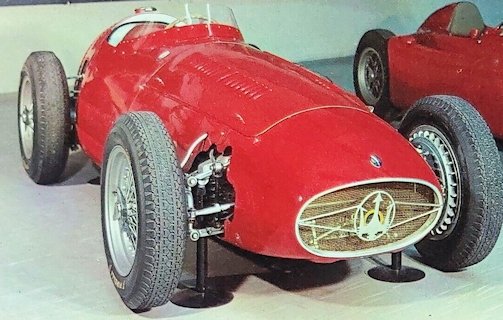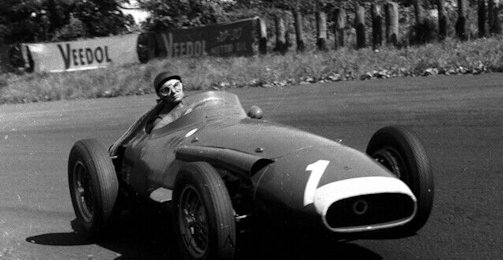Maserati 250F T1 Grand Prix Car
 | |
Builder | Maserati |
Class | Race Car |
Category | Formula 1 |
Teams | Officine Alfieri Maserati |
Designed by | Gioachino Colombo |
Chassis | Tubular |
Motor | Maserati 2.5 L6 |
Transmission | 5-speed manual. Rear-wheel Drive |
Fuel | Shell |
Tyres | Pirelli |
Debut | Argentine Grand Prix 1954 |
The Maserati 250F is a Formula 1 single-seater, used between 1954 and 1960. The Maserati 250F was a Formula One single-seater racing car built at Maserati from 1954 to 1958 and used in the World Championship until 1960.
History
The Maserati 250F was one of the best and most durable Formula 1 cars in Grand Prix history. The planning at Maserati originally intended to develop the car only for use by private individuals. Since these teams operated with limited financial and technical resources, the car had to be simply constructed.
Initially, the 250F was referred to as 6C2500. After the first test drives, he received the designation 250F. The number "250" stood for the cubic capacity of 2500 cc and the "F" for formula. The basis of the 250F was the Maserati A6GCM. Thus, of the 33 built specimens, five were derived from this model. The A6GCM was rebuilt to 250F. 22 pieces were planned from the start and were also manufactured, six 250F were conversions of existing cars, which were only renumbered.

The car was powered by a 6-cylinder in-line engine with dry sump lubrication initially developed by Gioachino Colombo and subsequently improved with the help of Vittorio Bellentani. It had two valves per cylinder (intake Ø 42 mm, exhaust Ø 38 mm) inclined at 77° operated via finger rockers by two overhead camshafts moved by a cascade of gears in front of the cylinder block and recalled by helical springs. The cylinder liners were 'wet' in the upper section and 'dry' in the lower section. The crankshaft was made of nitrided steel and rested on seven supports. The ignition was with double spark plugs, powered by two magnetos. Gioacchino Colombo and Alberto Massimino were responsible for the immortal 2.5-litre six-cylinder Maserati Grand Prix car which proved so widely popular in the 1950s Formula. Maserati at Modena went into virtual mass-production of these cars, over 30 being constructed, all eventually sold into private hands. Characteristically, Maserati had always supplied privateers with cars, often before their own works team vehicles were completed, and this was so with the 250F.
Introduced in 1954, the model won its first race, the Argentine Grand Prix, driven of course by the great Juan Manuel Fangio. Later that year and throughout 1955 the cars were generally outclassed by Mercedes-Benz in Grand Prix racing, but they were generally next best, and they utterly excelled in the many minor non-Championship Formula 1 events run in Europe at that time.
The 250F used a multi-tubular spaceframe chassis of the current vogue with double-wishbone and coil-spring front suspension and a De Dion rear end with transverse leaf-spring. A neat gearbox was in unit with the final-drive assembly between the rear wheels and the 84 mm x 75 mm 2.49-litre six-cylinder engine with twin overhead camshafts and three twin-choke carburettors produced around 260 bhp.
Performance:
- Power: 240 HP at 7200 rpm.
- Max power, 240 bhp at 7200 rpm rising to 270 bhp at 8000 rpm.
- Speed: 170 mph (270 kmh).
- Maximum Speed: 274km/h (170mph)
In 1956 Moss drove for Maserati, having campaigned a private 250F to such effect in 1954 that he had won his Mercedes-Benz drive for '55. Moss won at Monaco in 1956 but Fangio was too good in the Lancia-Ferrari and won the Championship. Then in 1957 Fangio rejoined Maserati—his second love after Alfa Romeo—and in a classical season won the Argentine, Monaco, French and a tremendously dramatic German Grand Prix to clinch his fifth and final World Drivers' Championship. During that year a 68.5 mm x 56mm 2449cc V 12 engine was tried in 250F chassis but follies in sports car racing cost Maserati dear and they were forced to pull in their horns for 1958. Some lightweight 'Piccolo' Maserati
250Fs were built, in one of which Fangio ran his last race—the French Grand Prix of 1958 and 250Fs in private hands raced on even into the very last 2.5-litre Grand Prix, the US event in 1960.
Vittorio Bellentani and Gioacchino Colombo agreed on the basics of the car. The six-cylinder engine was derived from the engine of the A6GCM. The cast-iron cylinder liners were placed in an aluminium engine block heated to 160 degrees in an oil bath. The compression was 12: 1. Two overhead camshafts moved two valves per cylinder. The four-speed gearbox was in the rear, to achieve an optimal weight distribution. The tubular frame carried a front axle with coil springs and lever shock absorbers. Rear, the 250F had a De Dion axle with transverse leaf springs and lever shock absorbers. The body with a cockpit, which offered the driver more space than comparable racing cars of the era delivered Fantuzzi.
Colombo was no longer able to follow the completion of the first 250F as he moved from Maserati to Bugatti to advance their Formula One project.

Notable 1st place Races for the Maserati 250F F1
- 1954, Argentinian Grand Prix, Juan Manuel Fangio (1st place)
- 1954, Belgium Grand Prix, Juan Manuel Fangio (1st place)
- 1956, Monaco Grand Prix, Stirling Moss (1st place)
- 1956, Monza Grand Prix, Stirling Moss (1st place)
1954
The car made his debut at the 1954 Argentine Grand Prix, winning the race with Juan Manuel Fangio, who also took the Belgian Grand Prix at the end of June, before moving to the Mercedes team. The points obtained with the two teams allowed the Italian-Argentine driver to win the World Drivers' Title. In the same year Stirling Moss drove a Maserati 250F As a private for the entire season with Juan Manuel Fangio at the wheel. Fangio, who soon left Maserati to switch to Mercedes Benz, drove the 250F as an unofficial factory car and made for a perfect maiden win. Also, at the second race in Belgium Fangio was successful. These successes led Maserati to set up an official factory team, which made it difficult for the factory to fulfil all customer orders within the agreed time. Therefore, the five A6GCM were used and converted into 250F. These cars were, mainly because of the outdated landing gear, the inferior 250F but. You could recognize the converted A6GCM to the outside of the body running tie rods., The factory team was next to Luigi Musso, Roberto Mieres and Onofre Marimón and Harry Schell.
1955
The following season, despite the move of Moss to Mercedes and designers Vittorio Bellentani and Alberto Massimino to Ferrari, the 250F had important new developments with the 5-speed gearbox and a new injection system.
Even before Mercedes-Benz tested in 1955 Maserati a Bosch injection. Although the injection was not used for the time being, the findings flowed into the injection systems, which were installed in Maserati sports cars. The transmission got a fifth gear and the outside dimensions were slightly reduced. Fantuzzi designed a new, more streamlined body, which was used in the car with the chassis number 2518. The new works driver Jean Behra finished fourth in the Italian Grand Prix. For the Mercedes-Benz race cars, however, the 250F remained without victory during the entire season.
1956
In 1956 Stirling Moss won the Monaco and Italian Grands Prix driving a private 250F. During the season, a "faired" version inspired by the Mercedes-Benz W196 "Type Monza" was tested and versions of the car were developed for the Formula 2 category. The following year Fangio achieved four successes including the epic German GP and became world champion for the fifth time. The experiments with the gasoline injection showed first fruits in 1956. A pump driven by a camshaft chain was installed in the 250F. The suspension has also been modified. The engine was rotated six degrees, allowing the prop shaft to bypass the driver's seat and lower the driver's seating position. Stirling Moss, now works driver at Maserati, won the Monaco Grand Prix and the Italian Grand Prix on Monza's high-speed track.
1957
For the 1957 season Maserati constructed a new tubular frame made of thin steel tubes. The exhaust pipes were led past the driver's windshield to the left on the left side, where they joined together to form a single pipe, which led to the rear wheels. The drum brakes were also revised. These improvements made the 250F the exceptional vehicle with which Juan Manuel Fangio clinched his fifth World Championship title. Maserati was already working on a V12 engine, which should extend the life of the 250F further, as the team management after the title win by Fangio for financial reasons, the resolution of the factory team announced.
Rating
Technical
-
Maserati 250F F1 Technical details and specifications (1954-1958)
ENGINE:
Maserati, six cylinders
Capacity: 2,493cc
inclined ohv with two ohcs
three double-choke Weber carburettors
Bore & Stroke: 84 x 75mmTRANSMISSION DRIVE LINE:
initially four-speed manual gearbox, from 1955 five-speed with reverse.
Clutch Dry multidisk
Fina/ Drive Shaft to bevel gearsCHASSIS:
tubular spaceframe.SUSPENSION:
Independent front suspension by double wishbones and coil springs.
Rear suspension, de Dion with transverse leaf springDIMENSIONS AND WEIGHT:
Length 13 ft 5 ins
Width 5 ft 4 ins
Wheelbase 7 ft 5 ins
Tyre size 5.50 X 16
Height 2 ft 10 ins
Weight 11 cwt (dry)
track, front 51 in (129 cm); rear, 49 in (124 cm).BRAKES:
4 wheel hydraulic (drums)© Motor car History




